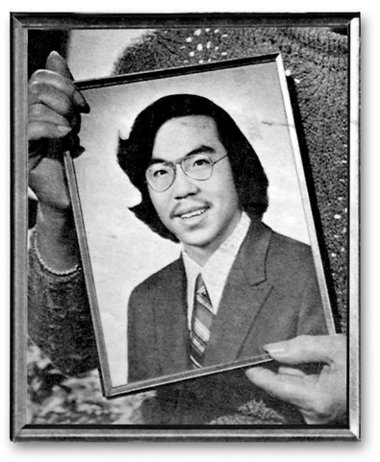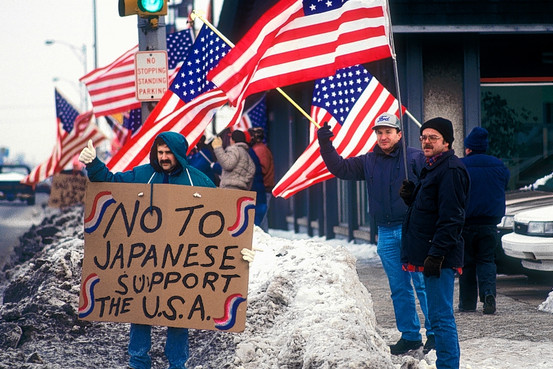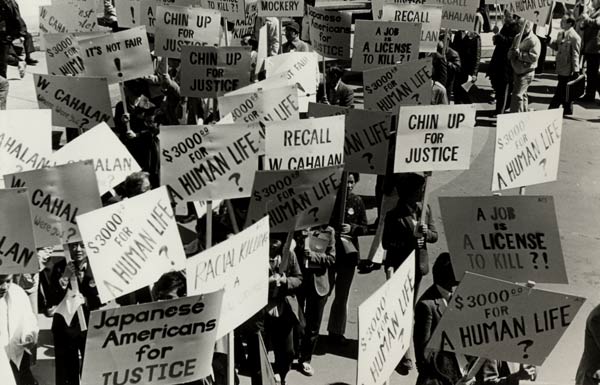by Ron Lare
July 23, 2012

In 1982, Ronald Ebens and Michael Nitz murdered Chinese-American Vincent Chin with baseball bat blows to the head in Highland Park (a separate city inside the borders of Detroit). Ebens and Nitz thought Chin was Japanese.
The fine film, “Who killed Vincent Chin?”, is clear enough about the story. However, most media coverage was and is not. This essay looks at the murder from my perspective as an autoworker. It argues that unity against anti-Asian racism is possible among autoworkers despite the image of autoworkers set forth in the media.
Were Ebens and Nitz Autoworkers?
It’s natural and right that Chin’s death prompted discussion of autoworker attitudes toward Asian people. In an early 1980s Detroit Labor Day Parade, I watched fellow autoworkers sledge-hammer a Toyota sitting atop an official parade float.
Judy Ancel wrote in an April 2009 “Labor Notes” discussion of international solidarity: “Vincent Chin, a Chinese-American engineer in Detroit, was beaten to death by a laid-off auto plant supervisor, who thought Chin was Japanese. The killer got probation.”
Ancel is right that the lead murderer was in management, not the UAW.
However, Iris Chang describes both Ebens and Nitz as “autoworkers” in “The Chinese in America” (2003), page 320: “In June 1982 in Detroit, Vincent Chin, the adopted son of a Chinese laundry owner, was beaten to death with a baseball bat by two disgruntled autoworkers who mistook him for Japanese.”
In fact, Ebens was a Chrysler Warren Truck Plant superintendent. Nitz, his stepson, was indeed an autoworker laid off from Chrysler. Chang writes, “Nitz held back Chin’s arms while Ebens shattered his skull.”
Ebens, the Chrysler superintendent, led the attack and wielded the murder weapon. In other words, the attack was led by a member of Chrysler management. Ebens served only a few months in jail, Nitz served none.
I have a direct interest in this question. I worked on auto plant shop floors from 1978 to 2008. I am a retired member of UAW Local 600, covering the Rouge Plant in Dearborn, near Detroit. For three years I was on the local union executive board.
In US auto plants, laid off workers are considered “autoworkers.”
Superintendents like the man who struck the death blows are not called autoworkers.
Are these simply fine details? Why not simply condemn this whole attack as murderous autoworker racism without saying more?
I ask myself the same question as I recall that Toyota-bashing float in the Detroit Labor Day Parade. Chin’s murderers, too, intended to lash out at Japanese imports and all Asian people. Whether or not Ebens was an autoworker, anti-Asian racism did–and does—exist among autoworkers. Could some autoworker, somewhere, have swung the bat on another night in 1982…or in 2012? I wouldn’t deny that possibility.
However, precision in fixing blame for murder matters. This is a legal principle and a popular standard of justice.
In deference to the real powers in our society, the media do not mention Chrysler management’s role in the murder. They implicitly blame the UAW and autoworker culture.
They blame labor, not capital.
To be sure, the murderers’ being white is very relevant. However, “autoworker” is commonly taken to mean “UAW member.” Ebens was not a UAW member. (I have not been able to determine whether Nitz was a UAW member at the time of the murder.)
If Ebens’ rage was the product of a racist culture, it was Chrysler Corporation management’s racist culture, not union culture.
If Ebens had heroically stopped a murder in the streets instead of committing one, would the media have identified him as an “autoworker,” or as a “Chrysler superintendent”?
I have sought to help fight racism on the shop floor and in society, whether racism is displayed in hiring, access to skilled trades, police brutality, fascist rallies, and discrimination against immigrants. Based on my experience, we will not get anti-racist working-class unity by telling autoworkers simply that “autoworkers” committed the murder when in fact a boss swung the bat.

The news media:
“Pacts help carmakers fight foreign rivals.”
Some UAW officials join the auto companies in invoking an Asian “yellow peril”. But the company and the media lead the charge. In coverage of 2003 UAW-Big 3 auto contracts, Detroit newspaper headlines read, “Pacts Help Carmakers Fight Foreign Rivals”. A video shown to workers in my plant depicted Asian nations’ flags swarming onto a US map like invading armies. No European auto manufacturer flags were depicted.
Contrary to stereotypes of autoworkers, there is a larger range of opinion on the shop floor than in management. This is partly because the shop floor is more racially diverse than is management. Yet some media seek out anti-Asian rank-and file autoworkers to interview rather than autoworkers with opposing views.
The 2002 anniversary of Chin’s death
The 20th anniversary of Chin’s death was commemorated in Detroit in 2002. My wife and I were about to travel to China to adopt our daughter. This helped focus me on the ghost of Vincent Chin. I spoke very briefly from the floor of the gathering on the theme of this essay and said the UAW should have sent official representatives. However, such union officials are not shop floor “autoworkers” either. We needed more autoworkers at the event.
Is progressive autoworker unity possible?
Frank Wu, former Dean of Wayne State University’s Law School in Detroit, is writing a book about Vincent Chin. He seeks to confirm a story about workers in Ebens’ plant walking off the job when they heard about his murder of Chin.
How big is anti-racist sentiment among workers?
Consider the late Detroit City Council member Maryann Mahaffey’s role at the 20th anniversary Vincent Chin event. I was not a supporter of Mahaffey’s, as I do not see the Democratic or Republican Parties as workers’ friends. But in 1983, Mahaffey gave a more militant speech than any union official at a Detroit rally for Greyhound strikers. During the 1995-1997 Detroit newspaper strike, a scab editorial threatened to move facilities out of Detroit if she did not leave the picket lines. Mahaffey’s political base included a progressive “labor left” among autoworkers who condemn Chin’s murder.
What does unity require?
Ebens was a boss—and not the lowliest one. He was a daily shop floor opponent of progressive autoworkers.
Let’s help autoworkers identify with opposition to Chin’s murderer, not imply that he was “one of us.” Let’s not stereotype autoworkers as responsible for the murder. We need both truth and unity to fight racism from the shop floor to the top floor.
On December 22, 2010, Ferndale, Michigan, a city just north of Detroit, established a memorial to Vincent Chin. This is located at the site where, as the Ferndale mayor said at the dedication, “the Chinese American community first began to organize and advocate for justice after the verdicts were handed down in the Vincent Chin case.”

Ron Lare is a member of United Auto Workers Local 600 in Detroit, Michigan.

Comments
3 responses to “Thirty years on: Did autoworkers kill Vincent Chin?”
Thanks for this thoughtful write-up. The UAW walk-off is mentioned in Ebens’ Wikipedia page, and cites court papers for authority, but I’ve wondered about this myself.